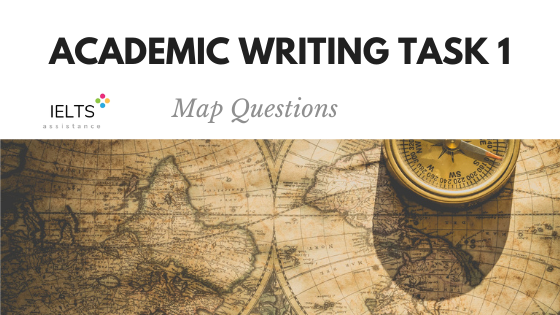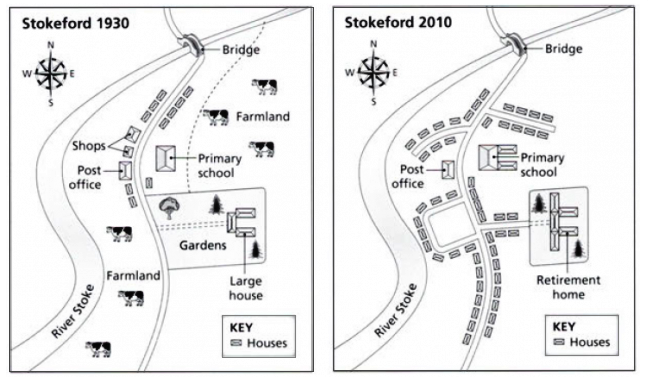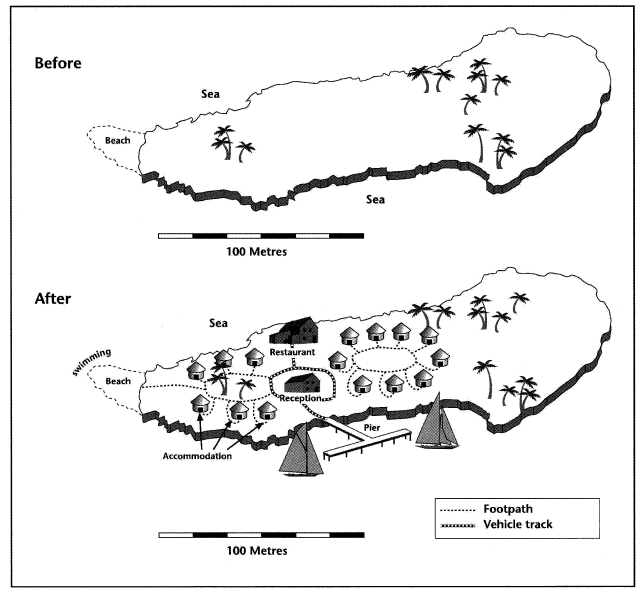Academic IELTS Writing Task 1
Map Questions

Overview
We will have a look at the following parts:
- The 3 different kinds of map questions
- How to plan Academic writing task 1 maps
- How to structure Academic writing task 1 maps
- How to Describe general changes
- How to Describe specific/ in-depth changes
- Example of Academic writing task 1 maps
One of the task you might need to do for Academic writing task 1 is describing a map. This questions is becoming more and more popular and due to lack of time in most IELTS course this type of question will not be covered. It’s not a difficult questions and you can score very high on it, if you are well prepared.
The 3 different kinds of map questions
There are 3 types of map questions:
- Describe 1 map in the present day. This is very rare, since you need to use the present simple and it is impossible for you to compare anything. This task is very basic and very easy to do.
- Compare 2 maps: 1 in the present and 1 in the future.This is less rare and you will have to use present and future tenses. The map is usually about future developments of a town/city. You will need the same vocabulary as number 1 and 3.
- Compare 2 maps: 1 in the past and 1 in the present. Number 3 is the most common and will be the main focus of this lesson. You will get 2 maps and asked to select and report the main features, and make comparisons where relevant. You will be using both present and past tenses, as well as vocabulary to describe the maps and how the town has developed. You will also be using the passive voice, as it is a man-made process.
Example of a map question

How to plan Academic writing task 1 maps
1.Read the task
Read the task carefully so you know what to need to do. Underline the key parts of the task. Find synonyms for the key words in the task, or map an write them down. (1 to 2 minutes max)
2.Analyze the map
Analyze the map thoroughly, look for the most notable things that have changed. Remember, you only have 150 words you can’t describe everything in details.
To help you analyse the map, you should ask yourself some general questions about the map to help you know what to write about:
- Were the changes enormous (very big) or negligible (very little) ?
- Were there any major or minor improvements on the infrastructure?
- Is the map more or less residential (more or less housing) ?
- Is there more or less nature?
- Are there more or less trees?
- Have some of the buildings changed and how?
- have the leisure facilities changed and how?
- Is there anything else that really changed?
Circle some of these areas that you think are important, and take some notes on your map. The examiner will only see your answer paper, so you can scribble as much as you want on the exam. ( 2 to 3 minutes)
These 2 key stages are crucial to score well on your task. You might think they are a waste of time, but they save you a lot more time when you are writing, since you know what to write about. Many times we have seen students stopping and thinking, what should I write next, just staring and not knowing what to do.
Another reason is ¼ of your score is task achievement, which is just making sure you answer the task correctly. If you just take these few minutes to make sure what you are doing you’ll score well.
3. Start writing
- Paraphrase the question and write it down (1 minute), this will go fast as you already wrote some synonyms down in the planning stage.
- Write your general overview by describing what is happening generally in 2 sentences. This is your general overview paragraph and we will show you how to write this in more detail below.
- Write your in-depth analysis, writing in more detail some of the most noteworthy changes you had circled before.
- Check your work for mistakes and correct them.
How to structure Academic writing task 1 maps
The easiest way to describe 2 maps is to use 4 paragraphs, like with any Academic IELTS writing.
- Paraphrase the question
- General overview
- In-depth changes
- In-depth changes
Paragraph 1 :Paraphrase the question using 1 or 2 sentences, while using synonyms.
Paragraph 2: General Overview. Write 2 or 3 sentences containing at least 2 general statements about the map, describing the maps generally, while writing about the most noticeable differences between the 2 maps.
Paragraph 3 and 4: The body:
You should group the information together either by time or location, depending on the question asked. So, 1 paragraph about changes at a certain time, the other paragraph about another time, or 1 paragraph about 1 location, the other about a different location.
- Paragraph 3, 3 to 4 sentences about specific changes
- Paragraph 4, 3 to 4 sentences about specific changes
How to Describe General Changes
All IELTS Academic task 1 writings have a general overview. Here you do not talk about the general changes in the graph, but the main differences between both maps. Therefore, pick 2 or 3 of the most noticeable changes on the map and write about them in your General overview. The more specific changes are for your main body.
Examples:
- Over the 10 year period, the area witnessed dramatic changes.
- From 1995 to 2005, the city centre saw some spectacular developments.
- The whole village changed considerably over the mentioned time period.
- During the 5 year period, the industrial area was fully transformed.
- Over the past 15 years, the residential area was completely reconstructed.
- Over the time period, the old docks were redeveloped.
- Between 1995 and 2005, the old houses were rebuilt.
- The central business district was completely modernised during the time period.
How to Describe Specific in-depth Changes
The most important part of the task is to describe changes. Most features of the map, like buildings, places, … will be labelled (have a name). All you need to do is figure out how these things have changed from the past to the present and the write about it. I know it’s easier said than done, but if you follow the structure and the instructions you’ll do great.
Example of Academic writing task 1
Now we can put everything together and have a look at a good example of Academic IELTS writing task 1, a map question.
The two maps below show an island, before and after the construction of some tourist facilities.
Summarize the information by selecting and reporting the main features, and make comparisons where relevant.

On Both maps an island is displayed, the first one shows what the island looked before touristic development, the second one after.
The island, which has palm trees, is approximately 250 metres long. It is surrounded by a sea and has a beach on the west side. Over an undisclosed period, the island was completely transformed with the addition of a hotel and a pier, however the eastern part of the island appears to have been left untouched .
The most noticeable additions are the hotel rooms. 6 buildings, surrounding some trees, have been built on the west of the island and 9 buildings have been constructed in the centre of the island. Between both accommodation areas, a reception area and a restaurant has been developed.
A pier, which is connected to the reception, has also been built on the south coast of the island, allowing yachts to dock and access the resort. Apart from the trees, the beach remains the only natural feature that has been relatively untouched, although it now has a swimming area.
(175 words)
If you need anymore help have a look at our Vocabulary for IELTS writing task 1 map questions. This will surely help you expand you lexical range and make it easier for you to deal with the task.
Until the end of the Early Bird Special and save 45%
Register now below
English Online IELTS course
Full price-
12 x 1.5 hour classes: 200£
-
4 full writing corrections: 80£
-
2 Full speaking exams: 80 £
-
Max 10 students
-
Additional practice
-
24/7 support
-
Total value: 360£
-
Save 30%
-
Course book 32£
English Online IELTS course
Full price + Friends reduction-
12 x 1.5 hour classes: 200£
-
4 full writing corrections: 80£
-
2 Full speaking exams: 80 £
-
Max 10 students
-
Additional practice
-
24/7 support
-
Total value: 360£
-
Save 35%
-
Course book 32£
English Online IELTS course
Early bird-
12 x 1.5 hour classes: 200£
-
4 full writing corrections: 80£
-
2 Full speaking exams: 80 £
-
Max 10 students
-
Additional practice
-
24/7 support
-
Total value: 360£
-
Save 45%
-
Course book 32£
English Online IELTS course
Early Bird + Friend-
12 x 1.5 hour classes: 200£
-
4 full writing corrections: 80£
-
2 Full speaking exams: 80 £
-
Max 10 students
-
Additional practice
-
24/7 support
-
Total value: 360£
-
Save 50%
-
Course book 32£
What our students say
Have a look at what our students have to say about IELTSassistance.co.uk
Get your writing and speaking corrected
Join the ever growing group of students who we helped on the road to success and get the professional help you have been looking for.
Useful Links
Writing Correction
Have one of our teachers look at your Writing Task and give feedback and correction within 24 Hours
Writing Task 1
Have a look at an overview of Academic IELTS Writing Task 1
Writing Task 1 Tips & Tricks
Have a look at some of the important tips and tricks to get a better score at Academic IELTS Writing Task 1
Writing Task 1 Grammar
Have a look at some of the grammar needed for Academic IELTS Writing Task 1
Writing Task 1 Vocabulary
Have a look at some of the vocabulary needed for the introduction and general overview of Academic IELTS Writing Task 1
Writing Task 1 Graphs
Have a look at how to deal with Graphs, how to analyse, structure, write,…
Writing Task 1 Graphs Examples
Have a look at some of the examples of Academic IELTS Writing Task 1 Graphs and see how other people deal with writing them.
Writing Task 1 Graphs Vocabulary Change
Have a look at some Graph Vocabulary to deal with Dynamic Graphs and Changes.
Writing Task 1 Graphs Vocabulary Numbers
Have a look at some Graph Vocabulary to deal with Graphs and Numbers.
Writing Task 1 Graphs Vocabulary Practice
Have a look at some exercises and practice some of the vocabulary used for Academic IELTS Writing Task 1 Graphs
Writing Task 1 Maps
Have a look at how to deal with Maps, how to analyse, structure, write,…
Writing Task 1 Maps Examples
Have a look at some of the examples of Academic IELTS Writing Task 1 Maps and see how other people deal with writing them.
Writing Task 1 Maps Vocabulary
Have a look at some of the vocabulary used for Academic Writing Task 1 Maps
Writing Task 1 Maps Vocabulary Practice
Have a look at some exercises and practice some of the vocabulary used for Academic IELTS Writing Task 1 Maps
Writing Task 1 Processes
Have a look at how to deal with Processes, how to analyse, structure, write,…
Writing Task 1 Processes Examples
Have a look at some of the examples of Academic IELTS Writing Task 1 Maps and see how other people deal with writing them.
Writing Task 2
Have a look at an overview of IELTS Writing Task 2 and how to deal with it.


2 Responses
How can we use the phrase ‘underwent a contracting phase’ in a map….?
Krishna Surendan, Thanks for your comment. We would like to help you but we will need some more information.
What do you mean by underwent a contracting phase? What kind of map are we talking about? What is the context? Why do you want to use this phrase?…
The more information you can give us the better we can help you.